Related Research Articles
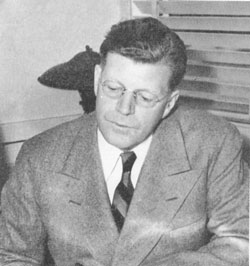
Frederick Clinton Quimby was an American animation producer and journalist best known for producing the Tom and Jerry cartoon series, for which he won seven Academy Awards for Best Animated Short Films. He was the film sales executive in charge of the Metro-Goldwyn-Mayer cartoon studio, which included Tex Avery, Droopy, Butch Dog, Barney Bear, Michael Lah and multiple one-shot cartoons, as well as William Hanna and Joseph Barbera, the creators of Tom and Jerry.

The Cat Concerto is a 1947 American one-reel animated cartoon and the 29th Tom and Jerry short, released to theatres on April 26, 1947. It was produced by Fred Quimby and directed by William Hanna and Joseph Barbera, with musical supervision by Scott Bradley, and animation by Kenneth Muse, Ed Barge and Irven Spence and uncredited animation by Don Patterson.
Tom and Jerry is an American animated media franchise and series of comedy short films created in 1940 by William Hanna and Joseph Barbera. Best known for its 161 theatrical short films by Metro-Goldwyn-Mayer, the series centers on the rivalry between the titular characters of a cat named Tom and a mouse named Jerry. Many shorts also feature several recurring characters.
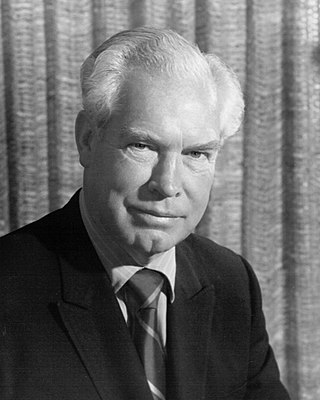
William Denby Hanna was an American animator, voice actor, and occasional musician who is best known for co-creating Tom and Jerry and providing the vocal effects for the series' title characters. Alongside Joseph Barbera, he also founded the animation studio and production company Hanna-Barbera.

Joseph "Joe" Roland Barbera was an American animator and cartoonist, best known as the co-founder of the animation studio Hanna-Barbera.
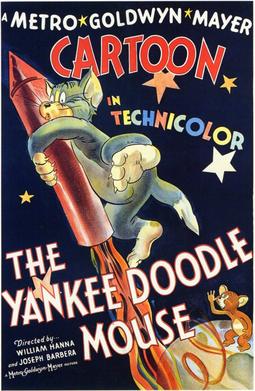
The Yankee Doodle Mouse is a 1943 American one-reel animated cartoon in Technicolor. It is the eleventh Tom and Jerry short produced by Fred Quimby, and directed by William Hanna and Joseph Barbera, with musical supervision by Scott Bradley and animation by Irven Spence, Pete Burness, Kenneth Muse and George Gordon. Jack Zander was credited on the original print, but his credit was omitted in the 1950 reissue. It was released to theaters on June 26, 1943 by Metro-Goldwyn Mayer. The short features Tom the cat and Jerry the mouse chasing each other in a pseudo-warfare style, and makes numerous references to World War II technology such as jeeps and dive bombers, represented by clever uses of common household items. The Yankee Doodle Mouse won the 1943 Oscar for Best Animated Short Film, making it the first of seven Tom and Jerry cartoons to receive this distinction.

Puss Gets the Boot is a 1940 American animated short film and is the first short in what would become the Tom and Jerry cartoon series, though neither are yet referred to by these names. It was directed by William Hanna and Joseph Barbera, and produced by Rudolf Ising. It is based on the Aesop's Fable, The Cat and the Mice. As was the practice of MGM shorts at the time, only Rudolf Ising is credited. It was released to theaters on February 10, 1940, by Metro-Goldwyn-Mayer.
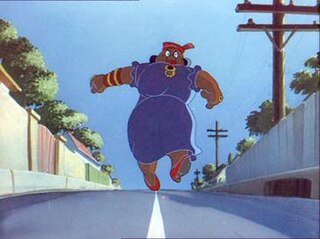
Mammy Two Shoes is a fictional character in MGM's Tom and Jerry cartoons. She is a fat middle-aged African American woman who is the housemaid in the house which Tom and Jerry reside. But the fact that she has her own bedroom in the short Sleepy-Time Tom (1951) raises the possibility of her being the owner of the house, as no other human is present in the house in shorts she appears. She would scold and attack Tom whenever she believed he was misbehaving; Jerry would sometimes be the cause of Tom's getting in trouble.

Mouse Trouble is a 1944 American one-reel animated cartoon short and is the 17th Tom and Jerry short produced by Fred Quimby. It was directed by William Hanna and Joseph Barbera, with music direction by Scott Bradley. The cartoon was animated by Ray Patterson, Irven Spence, Ken Muse and Pete Burness. Mouse Trouble won the 1944 Oscar for Best Animated Short Film, the second consecutive award bestowed upon the series. It was released in theatres on November 23, 1944 by Metro-Goldwyn Mayer and reissued on December 12, 1951.
This is a complete list of the 166 shorts in the Tom and Jerry series produced and released between 1940 and 2021. Of these, 162 are theatrical shorts, one is a made-for-TV short, one is a two-minute sketch shown as part of a telethon, and two are special shorts released on HBO Max.

The Little Orphan is a 1949 American one-reel animated cartoon and the 40th Tom and Jerry cartoon, released in theaters on April 30, 1949 by Metro-Goldwyn Mayer. It was produced by Fred Quimby and directed by William Hanna and Joseph Barbera, with music by Scott Bradley. The cartoon was animated by Irven Spence, Kenneth Muse, Ed Barge and Ray Patterson. The short features Nibbles, a young mouse who is insatiably hungry.
The Night Before Christmas is a 1941 American one-reel animated cartoon and is the third Tom and Jerry short directed by William Hanna and Joseph Barbera, produced by Fred Quimby and animated by Jack Zander, George Gordon, Irven Spence and Bill Littlejohn. It was nominated for the 1941 Academy Award for Best Short Subject: Cartoons, but lost to the Mickey Mouse short film Lend a Paw, making it the only Tom and Jerry cartoon to lose to a Disney film.

The Metro-Goldwyn-Mayer cartoon studio was an American animation studio operated by Metro-Goldwyn-Mayer (MGM) during the Golden Age of American animation. Active from 1939 until 1958, the studio was responsible for producing animated shorts to accompany MGM feature films in Loew's Theaters, which included popular cartoon characters Tom, Jerry, Droopy, Butch, Spike, Tyke, and Barney Bear.

Tot Watchers is a 1958 American one-reel animated Tom and Jerry short produced and directed by William Hanna and Joseph Barbera with music by Scott Bradley. The short was released by Metro-Goldwyn-Mayer on August 1, 1958. It is the 114th and last Tom and Jerry theatrical cartoon produced or directed by both Hanna and Barbera, and the last cartoon short of the series until Gene Deitch's Switchin' Kitten in 1961. Barbera would return to direct one final Tom and Jerry theatrical short, The Karate Guard, in 2005.

The Tom and Jerry Spotlight Collection is a series of two-disc DVD sets released by Warner Home Video. Originally planned as an uncensored, chronological set, the issued Spotlight Collection sets include selected Tom and Jerry shorts on each volume. Volume 1 was released on October 19, 2004, Volume 2 on October 25, 2005, and the third and final volume on September 11, 2007. On October 15, 2019, the set, which consists of 4 discs, was repackaged with some errors fixed.
Tee for Two is a 1945 American one-reel Technicolor animated cartoon and is the 20th Tom and Jerry short, first released to theaters on July 21, 1945, by Metro-Goldwyn-Mayer. The short is directed by William Hanna and Joseph Barbera, composed by Scott Bradley, and animated by Ray Patterson, Irven Spence, Pete Burness, and Kenneth Muse.
The Karate Guard is a 2005 American animated cartoon short film, and the 163rd Tom and Jerry short. Directed by Joseph Barbera and Spike Brandt, The Karate Guard was the last Tom and Jerry cartoon that Barbera worked on before his death in 2006. It had a limited theatrical release in cinemas throughout Los Angeles on September 27, 2005 by Warner Bros. Pictures, and had its television premiere on Cartoon Network on January 27, 2006.
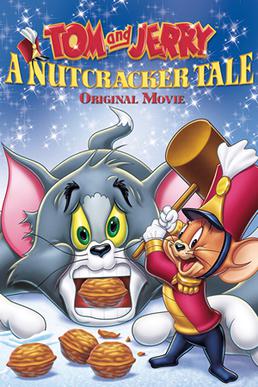
Tom and Jerry: A Nutcracker Tale is a 2007 American direct-to-video animated Christmas fantasy comedy film. The film was produced by Warner Bros. Animation and Turner Entertainment Co., and is the first Tom and Jerry film directed by Spike Brandt and Tony Cervone. It serves as the fifth direct-to-video Tom and Jerry film and is a semi-adaptation of 1816 short story "The Nutcracker and the Mouse King" by E. T. A. Hoffmann, with Jerry in the role of the Nutcracker and Tom in the role of one of the Mouse King's henchmen.
Tom and Jerry Golden Collection was a scrapped series of two-disc DVD and Blu-ray sets produced by Warner Home Video that was expected to collect all 161 theatrical Tom and Jerry cartoon shorts released by Metro-Goldwyn-Mayer from the 1940s through the 1960s. Only the first of the three planned volumes was released, on October 25, 2011. It features 37 shorts, roughly one-third of the 113 Tom and Jerry shorts that had been included in the Tom and Jerry Spotlight Collection, a previous DVD series that focused on the shorts directed by William Hanna and Joseph Barbera from 1940 to 1958.

The Tom and Jerry Deluxe Anniversary Collection is a two-disc DVD set, released by Warner Home Video.
References
- 1 2 3 "Tom and Jerry" (PDF). Johann Strauss Society of New York. 2011. Archived from the original (PDF) on April 25, 2012.
- 1 2 3 Samerdyke, Michael (August 28, 2014). "1953". Cartoon Carnival: A Critical Guide to the Best Cartoons from Warner Brothers, MGM, Walter Lantz and DePatie-Freleng. Lulu Press, Inc. ISBN 978-1-31-247007-1 . Retrieved 13 October 2020.
- ↑ "Johann Mouse (Two records)". The Billboard. The Billboard Publishing Company. May 23, 1953. p. 136. Retrieved October 13, 2020.
- ↑ Ehrbar, Greg (April 8, 2014). "Tom & Jerry on Record". Cartoon Research . Retrieved October 13, 2020.
- 1 2 3 Simon, Ben (February 25, 2008). "Warner Bros. Academy Award Animation Collection: 15 Winners, 26 Nominees". Animated Views. Retrieved October 13, 2019.
- ↑ Korkis, Jim (August 15, 2014). "Animation Anecdotes #175". Cartoon Research . Retrieved October 13, 2020.
- ↑ Tom & Jerry cartoon festival, featuring "Johann Mouse". OCLC 12572234 . Retrieved October 13, 2020– via WorldCat.
- ↑ Bowker's Complete Video Directory 2000: Volume 2. New Providence, New Jersey: R. R. Bowker. 2000. p. 1597. ISBN 9780835243094 . Retrieved October 13, 2020.
Video Released Oct. 1990...
- ↑ Beierle, Aaron (March 21, 2000). "Tom and Jerry's Greatest Chases". DVD Talk. DVDTalk.com. Retrieved October 13, 2020.
- ↑ Miller III, Randy (October 20, 2004). "Tom and Jerry: Spotlight Collection". DVD Talk. DVDTalk.com. Retrieved October 13, 2020.
- ↑ Rich, Jamie S. (June 20, 2010). "Tom & Jerry: Deluxe Anniversary Collection". DVD Talk. DVDTalk.com. Retrieved October 13, 2020.